Helen Lowe's Blog, page 282
October 12, 2011
Just Arrived: "The Kingdom of Gods" by NK Jemisin and "Oracle's Fire" by Mary Victoria
By some fortuitous alchemy the two books in the title arrived at the same time, and both are the third and final books in their respective series—NK Jemisin's Inheritance trilogy and Mary Victoria's Chronicles of the Tree. But there is more: the first in each series, The Hundred Thousand Kingdoms and Tymon's Flight respectively, were nominated for Gemmell Awards this year—both in the Morningstar category for "Best Fantasy Newcomer/Debut."
At any rate, I am very excited to have the final book in both these series finally in my hands and am looking forward to some quality reading time—on the sofa of course  —in the near future.
—in the near future.
Now let's see what the back covers say …
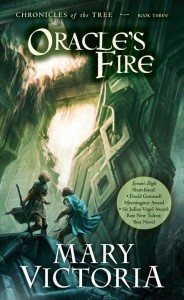 Oracle's Fire
Oracle's Fire"The Tree is all the world. And that world is dying …
After Samiha is thrown from the docks in Argos city, Tymon is condemned to a life of slavery in a Tree mine. During his ordeals, he glimpses a vision of his love and becomes obsessed by the thought that she is alive. When disaster strikes … he is left wandering the tunnels at the heart of the Tree, clinging to the hope that he might find her once again.
Meanwhile, the Saint's crusade is tearing the Four Canopies apart, and Lace and his Masters pursue their own deadly palns. Even as Tymon travels deep into the Tree, the Envoy's acolytes are sent out on a mission to Lacuna, the legendary world below … "
The cover art is by Frank Victoria.
The official launch party for Oracle's Fire is 23 October, 12 noon at the Weta Cave in Wellington.
—
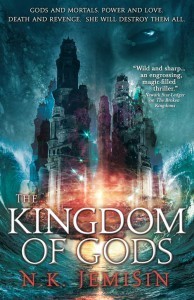 The Kingdom of Gods
The Kingdom of Gods"Gods and mortals. Power and love. Death and revenge. She will destroy them all.
For two thousand years the Arameri family has ruled the world by enslaving the very gods that created mortalkind. Now the gods are free and the Arameri's ruthless grip is slipping. Yet they are all that stands between peace and unending war.
Shahar, last scion of the Arameri family, must choose her loyalties. She yearns to trust Sieh, the godling she loves. Yet her duty as heir is to uphold the family's interests, even if that means destroying everyone she cares for.
As terrible new magics consume the world, the Maelstrom — which even gods fear — is summoned forth. Can Shahar and Sieh, mortal and god, stand together against the chaos threatening the kingdom of gods?"
The cover art is by Cliff Nielsen
—
And did you notice—both synopses centre as much around love and relationship as conflict? I can see that I have some interesting reading ahead!
How about you? What are you reading or recommending right now?
October 11, 2011
Guest Post on SF Signal—"Looking at the Stars: Why Epic Fantasy Keeps 'Speaking' To Us"
I have a guest post on SF Signal today—Looking at the Stars: Why Epic Fantasy Keeps 'Speaking' To Us. You can check it out here.
Doing Interviews
 As you know, I have done a few interviews on the blog already, collected here, and hope to bring a few more to you soon. Over the past few years, I have also done a good many interviews on a local radio station, Plains 96.9 FM, mostly with poets—including New Zealand's inaugural Poet Laureate, Michele Leggott—but also with such well known novelists as Andrea Levy, Nalini Singh, and Jennifer Fallon.
As you know, I have done a few interviews on the blog already, collected here, and hope to bring a few more to you soon. Over the past few years, I have also done a good many interviews on a local radio station, Plains 96.9 FM, mostly with poets—including New Zealand's inaugural Poet Laureate, Michele Leggott—but also with such well known novelists as Andrea Levy, Nalini Singh, and Jennifer Fallon.
I enjoy doing interviews, and so felt very honoured to win Plains FM's "Most Popular Podcast" (ie listened to interview) award 2010. And as with all aspects of my work, I do have a 'philosophy' in how I approach interviewing.
Mainly, that it's all about the interviewee—about trying to find the best questions to allow the person being interviewed and their work to shine through.
In order to find those questions, I have to do homework: read the interviewee's work, see if I can find other interviews they've done—not just to see what she/he has said before, but also so I don't ask all the same questions as every other interviewer, ie it's nice to present some fresh material, for the sake of the interviewee, but also for listeners/readers.
I like to take time over the questions as well, and think about what topics will best illuminate the interviewee's work, and what listeners/readers might find most interesting.
No matter how carefully I've thought about the questions though, when I'm actually doing the interview there can be no "script." If something interesting comes up then I have to follow that up—which is often when the best interviews "spark."
But I always have a back up question—or three!—especially on air, in case 'the best ever, surefire question' falls flat on its face!
Always though, when thinking about interviews, I come back to that first point—good interview is always about the interviewee. If the person doing the bulk of the "talking" is me, then I have failed as an interviewer.
I hope, however, this does not happen often—and that you will enjoy the interviews on the blog so far, and those to come.
October 10, 2011
Tuesday Poem: "She asked me if she took one pill … " by Glenn Colquhoun
She asked me if she took one pill for her
heart and one pill for her hips and one pill
for her chest and one pill for her blood
how come they would all know which part
of her body they should go to
I explained to her that active metabolites in each
pharmaceutical would adopt a spatial configuration
leading to an exact interface with receptor molecules
on the cellular surfaces of the target structures
involved.
She told me not to bullshit her.
I told her that each pill had a different shape and that
each part of her body had a different shape and that
her pills could only work when both these shapes could
fit together.
She said I had no right to talk about the shape of her
body.
I said that each pill was a key and that her body was
ten thousand locks.
She said she wasn't going to swallow that.
I told her that they worked by magic.
She asked me why I didn't say that in the first place.
.
© Glenn Colquhoun
~ published in Playing God, Steele Roberts, 2002
Reproduced here with permission.
—
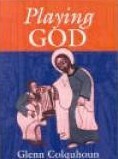 About the Poem:
About the Poem:On September 16, in a post titled Reflections on What I'm Reading, I talked about poet and doctor Glenn Colquhoun's speech on "The Therapeutic Uses of Ache" to the Royal College of General Practitioners in Wellington in 2009—and how re-reading it "reminded me all over again what an acute observer Glenn Colquhoun is and how I need to read his collection Playing God again, and maybe even share some of the poems with you of a Tuesday."
Playing God was published in 2002 to a level of critical and popular acclaim not often afforded poetry collections, receiving the Montana Award for Poetry and the Montana Readers' Choice Award at the 2003 Montana New Zealand Book Awards.
The collection draws on Colquhoun's experience of medicine, a profession in which doctors are often accused on "playing God", and reflects humour, pathos, and the frustration and heartbreak of a calling where:
"On the seventh day bacteria were made resistant to antibiotics.
New viruses were discovered in Africa. The drinking age was
lowered. In a regular column the British Medical Journal reported
a large increase in deaths attributed to earthquakes, pestilence,
lightning, famine, and flood."
~ from 1. Creation
and the doctor
"Contrary to popular opinion
I cannot raise the dead."
~ from 7. Myths
And where
"All miracles here
are usually performed
by various members of
the domestic staff."
~ from 3. Performing miracles
As you may guess from these quotes, I have quite a few poems in Playing God bookmarked—and had corresponding difficulty in deciding which poem to feature as today's Tuesday Poem.
In the end, I chose "She asked me if she took one pill … " because it is one of the few poems I have read that made me laugh out loud on first reading. But who was I laughing at: the patient, the doctor, the system, myself as the reader? One of the things I love about this poem is its layers of humour, tinged with irony, and driven by that acute observation that characterises Glenn Colquhoun. And because I didn't feel that I was laughing at anyone; I was laughing with everyone. I still grin every time I re-read it.
About the Poet:
Glenn Colquhoun is a doctor, poet and children's writer. His first poetry collection, The Art of Walking Upright, won Best First Book of Poetry at the 2000 Montana New Zealand Book Awards. In 2003 he won the Poetry Category and also became the first poet to be awarded the coveted Montana Readers' Choice Award, both awards for Playing God. He has written several children's books and has been the convener of the New Zealand Post Book Awards. In 2004, Colquhoun was the recipient of the prestigious Prize in Modern Letters.
October 9, 2011
Gettin' In The Mode

Storm on the Wall of Night; art by Peter Fitzpatrick
As I posted last week, I have begun working seriously on Daughter of Blood, The Wall of Night Book Three. But as with all big projects often there can be a period of "getting in the mode" when you have to work yourself into the project—well, I do anyway!
If the question is: "So how do you do this?"; the answer is: "It's different for each book.'
With both Thornspell and The Heir of Night I had an initial idea spark and then wrote from that point, the plot and characters building themselves in a process of evolving story. In the case of The Gathering of the Lost, I had had the opening scene of the story in my head for a long time. It then became a matter of integrating that opening scene with the story threads I was bringing through from Heir.
With Blood, I'm finding that I'm doing a lot of thinking about the plot threads from both Heir and Gathering, and where this story needs to go, and where it could go—more of a "hey, let's sit back a bit and take a good look at the terrain", rather than "dive in and swim for it" approach.
The diving in and swimming is still going to happen, and once it does then I am pretty sure that the plot and characters will start building and evolving, just as they have in all my previous books. But right now I'm aiming for a good understanding of my story arc, especially looking ahead to WALL 4, before I take that final, irrevocable dive into the deeper writing waters.
A big part of getting in the mode, then, is thinking—about plot threads, but also a great deal about each of the main characters and what is happening with all their stories, as well as what's going to happen to them, moving forward … As I wrote last year, here, that can change sometimes along the way, but in order to understand and manage the change, first of all you have have to have a clear idea of what you are changing from.
So yup, simply thinking—asking questions and also thinking through answers—is a really important part of "gettin' in the mode" with a new book.
October 8, 2011
Fun With Friends
There's a few fun things coming up around writing & writing friends, so Sunday morning—which it is here in NZ, and a bright sunny one, too—seemed a good time for a bit of a round up.

Christchurch South Library; photo credit Geoff Trotter
Christchurch Friends of the Library, Tuesday 18, 12.30 pm at the South Library, 66 Colombo St (cnr Colombo and Hunter Terrace)
Just a reminder that I will be speaking to the Christchurch Friends of the Library on Tuesday 18 at the South Library in Beckenham. I shall be reading from some of my recent works and talking about my personal path to international publication. The event begins at 12.30 pm and the entry is by 'gold' coin.
—
Canterbury Poets Collective (CPC) presents Poetry in Performance—the 2011 Spring Season, CPIT Students Assn (CPSA) Hall, 5 Madras Street
The annual autumn season of poetry readings had to be cancelled because of the February 22nd and ongoing earthquakes, but now it's spring and the CPC is back for eight weeks, every Wednesday from 19 October. Each evening will commence at 6.30 pm with an open mic, followed by a fabulous lineup of guest and local poets. I don't have an entry fee on the notice I received, but usually it's been $5.
Wednesday 19 Guest Poets: Vincent O'Sullivan, Jan Hutchison, Christina Stachurski
—
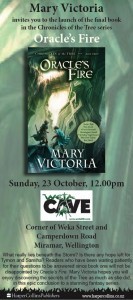 Mary Victoria & The Launch of Oracle's Fire, Sunday 23 October, 12 noon at the Weta Cave (cnr of Weka St & Camperdown Roads), Miramar,
Wellington
Mary Victoria & The Launch of Oracle's Fire, Sunday 23 October, 12 noon at the Weta Cave (cnr of Weka St & Camperdown Roads), Miramar,
Wellington
Woot! The big day is here at last, with Mary Victoria launching Oracle's Fire, the third and final novel in her Chronicles of the Tree series, at the Weta Cave in Wellington. Come one, come all, and help Mary celebrate the culmination of her debut Fantasy series—we aim to have loads of fun!
And if you want to catch a sneak preview—you can hear international voiceover artist, Bob Kuhn, reading an excerpt frm Oracle's Fire here.
—
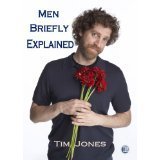 And Last But Not Least—Tim Jones & the "Men Briefly Explained" Tour
And Last But Not Least—Tim Jones & the "Men Briefly Explained" Tour
Another good friend, poet and 'interstitial' fiction author, Tim Jones, will shortly be on the road with Interactive Press to launch his third poetry collection, Men Briefly Explained, together with fellow poet Keith Westwater (with Tongues of Ash.) I'm looking forward to the Christchurch event with Tim on October 26, but there are events happening throughout the country:
Dunedin: Tuesday, 25 October, Circadian Rhythm Café, 72 St Andrew Street, 8pm
Christchurch: Wednesday, 26 October, CPIT, Madras Street, 5:30pm
Wellington: Thursday, 27 October, Wellington Central Library, 5:30 for 6pm
Lower Hutt: Friday, 28 October, Rona Gallery/Bookshop, Eastbourne, 6pm
Auckland: Tuesday 1 November, Poetry Live, Thirsty Dog, 469 Karangahape Road, 8pm
You can also see these, and signal your attendance, on the Facebook events page, here.
Tim's also been featuring a few of the poems from Men Briefly Explained as part of the Tuesday Poem blog recently and was also the featured poet, with Shetland Ponies, Haast Beach, on the Tuesday Poem Hub on August 16. Here are links to a couple more of the featured poems:
Men at Sea
happened to meet
—
And don't forget there are interviews with Daniel Abraham and Mary Victoria coming up on the blog in the next few weeks, as well as more great poets to be featured every Tuesday, all right here " … on Anything, Really." 
October 7, 2011
Sense of Place 2
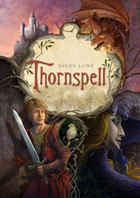 On Thursday I also posted about Sense of Place, mainly discussing it in the context of Haarth, The Wall of Night series world.
On Thursday I also posted about Sense of Place, mainly discussing it in the context of Haarth, The Wall of Night series world.
Luke commented saying: "Do you think it's easier to achieve a strong sense of place in an alternate world, like Haarth in "The Heir of Night", as opposed to "Thornspell" which you have said in a number of places is pretty much this world and 'almost but not quite' Holy Roman Empire?"
I have reflected on this a little and overall I don't think it is "easier." At one level, creating an alternate world may give you more freedom to create things the way you want, but conversely, choosing places within this world for your setting leaves you free to draw out the details that support your story and focus on other aspects of the story.
Using Thornspell as an example, sense of place is still very strong there–in the opening sequence where Sigismund first encounters the enchanted wood, and the later forest of Thorn; in the description of the sleeping palace and also the capital city of 'kingdom not so very far away' where the story is set.
 Thornspell has an historical setting, but I can also think of some contemporary urban fantasies where the use of real-world places are used to powerful 'world building' effect. Neil Gaiman's American Gods would be one for me, also Tim Powers' Las Vegas and Los Angeles in Last Call and Expiration Date respectively. In terms of almost-but-not-quite-this-contemporary-world building, I personally don't think you can go past Robin McKinley's urban fantasy, Sunshine, or Charles De Lint's Newport, the setting for many of his novels, all of which have a unqiuely North american flavour
Thornspell has an historical setting, but I can also think of some contemporary urban fantasies where the use of real-world places are used to powerful 'world building' effect. Neil Gaiman's American Gods would be one for me, also Tim Powers' Las Vegas and Los Angeles in Last Call and Expiration Date respectively. In terms of almost-but-not-quite-this-contemporary-world building, I personally don't think you can go past Robin McKinley's urban fantasy, Sunshine, or Charles De Lint's Newport, the setting for many of his novels, all of which have a unqiuely North american flavour …
…
In all these stories the sense of place is very strong, almost a character in its own right, and I feel that this sort of world building would have taken considerable imagination and craft. And I know that I personally put as much care into the world building aspect of Thornspell as I did with both The Heir of Night and The Gathering of the Lost. So my 'long answer' to your excellent question, Luke, is that I don't think it is necessarily easier, just different—and as always, with (imho) good fiction, driven by the needs of the story, not the preferences of the author.
October 6, 2011
Placido Domingo and Katherine Jenkins in Christchurch
Last night I got to go and hear Placido Domingo and Katherine Jenkins in concert with the New Zealand National Youth Orchestra, conducted by Eugene Kohn—and it was ah-maz-ing! Words really can't express the wonderfulness of the evening—the colour, the music, the voices—but I might try a little later in the day!  For the moment though, I'm still in wow mode!
For the moment though, I'm still in wow mode!
October 5, 2011
Sense of Place
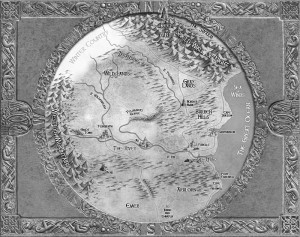
"The Heir Of Night" map: artist, Peter Fitzpatrick
You know, I was going to start this post and say, "Last week I talked about …" But then I looked back and found that it wasn't last week at all, but in fact September 21—two weeks ago yesterday!—that I posted on "Celebrating the Seasons in The Gathering of the Lost." As I so succinctly phrased it in my September 1 post on the Supernatural Underground: "Where Does Time Go?" (And don't even get me started on the impending doom that is Christmas!)
Anyway, back to core business! September 21 was the spring equinox—autumn in the northern hemisphere—and that got me thinking about the influence of seasonal change, and cultural celebrations associated with that, on The Gathering of the Lost (The Wall of Night Book Two) story. To find out more than that, you'll have to read the post, here. 
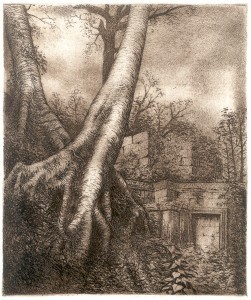
Jaransor; art by Peter Fitzpatrick
As I've also mentioned over the past few weeks, part of my prep. for getting into Daughter of Blood (The Wall of Night Book Three) has been going through Gathering and picking up story threads. In doing this, I've also noticed that sense of place is also a very strong influence on the evolving story. In The Heir of Night (The Wall of Night Book One) I explored four main environments: the Wall of Night itself, the adjoining Gray Lands, the hills of Jaransor, and of course the Gate of Dreams—each with its own distinctive character. And even then, there is often reference to the wider world of Haarth:
" … Malian rested one forefinger on the table that was one of the greatest treasures … in the Earl's quarter of the New Keep. A map of the Wall and all the known lands of Haarth had been etched into the wood and inlaid with precious metals to show the salient details of each country. A sinuous vein of gold marked the River, the mighty Ijir with its two great tributaries and multitude of prosperous city states, all built on the back of the river trade. Each city was picked out in a minute precision of turrets or minarets or spires, depending on its character, and in whatever heraldic colors had belonged to it when the table was made.
Malian's dark, slender brows were drawn together, the set of her young mouth thoughtful as she spun the table surface slowly round, so that the Wall and surrounding Gray Lands gave way to the Barren Hills, then to the River and all the countries to the south. A line of pewter marked the thousand leagues of road that ran from Emer to fabled Ishnapur and beyond that again was the vast and unknown desert, a sea of dunes wrought in jasper, topaz and bronze.
It was all so vast. Even the Winter Country, which was considered close, was a very long way from the Keep of Winds, with both the Wall mountains and league on league of Gray Lands in between … "
The Gathering of the Lost brings in new environments from places marked on that map—and reading through the manuscript, I like to think that they are as distinctive, in terms of 'sense of place' as the original four from The Heir of Night (which do still come into the new book.) In fact, the 5 parts of the Gathering story are named either for one of the seasonal festivals discussed on September 21—or for a place or region in the Haarth world. One of them at least you 'should' recognise from Heir: it's The Border Mark.
But reading that map extract from Heir—is there anywhere in the Haarth world where you'd like to find out more in terms of "sense of place?"
October 4, 2011
What I'm Reading: "Lion of Senet" by Jennifer Fallon
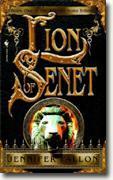 Last Friday I posted about comfort reading—how we turn to certain books and authors just because they're familiar and we know we're not going to go wrongwith any of their stories.
Last Friday I posted about comfort reading—how we turn to certain books and authors just because they're familiar and we know we're not going to go wrongwith any of their stories.
The converse situation is when there are books and authors you've just taken far too long to get around to reading. Jennifer Fallon is one of those authors, Lion of Senet one of those books.
And yes, "I know"—Lion of Senet first came out in 2002, so I'm definitely behind the times. But better late than never, I say!
At any rate, I had the opportunity to read it recently and enjoyed the ride. I liked the SciFi elements to what is essentially a Fantasy story, with the world that has two suns—one a dwarf, if I have understood the book correctly, orbiting a larger star. Plus the backstory of science versus religion. I also enjoyed the characters—well, except for Tia who really was a very annoying girl, but then, I think she was meant to be so I don't think that can be held up as a criticism of the book!
The character I enjoyed most though, was Antonov Latanya, the "Lion of Senet" for whom the book is named—mainly because of the layers to his personality. He is a sincerely religious zealot who nonetheless uses religion to further his worldly political purposes; charming and generous when it pleases him, cruel and sadistic when it suits. Singleminded and ruthless, certainly; also clever. In many ways he is typical of princes of the renaissance era, but I enjoyed that duality being brought to the page of a fantasy novel where there is a tendency to paint characters in black and white.
And characters aside, I'm definitely interested enough in the twists and turns of the story to be hunting out the next book, which I think is Eye of the Labyrinth. Yes indeed, I want to know what happens next!



